#elm shakespeare
Explore tagged Tumblr posts
Text
“I see myself in Beatrice,” added Herbert, a senior who learned the role on short notice after another student left the show. “She’s kind of feministic, and I love the fact that she’s able to voice her opinions and not be afraid of alienating suitors. It’s about focusing on yourself.”
5 notes
·
View notes
Text
Interesting article. A deep dive that connects the search for knowledge to horror movie tropes/subverted tropes while quoting Shakespeare, Eliot, and Chekhov. Something Is Rotten in Horror’s Use of Pedagogy
1 note
·
View note
Text

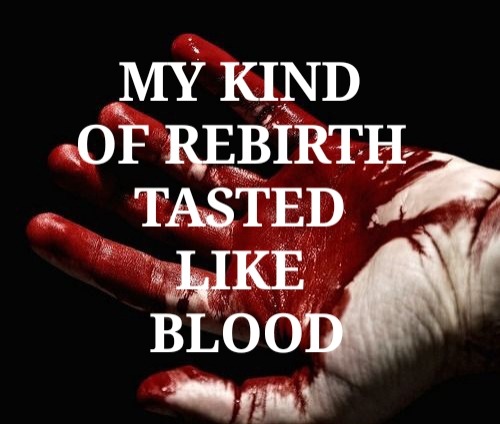


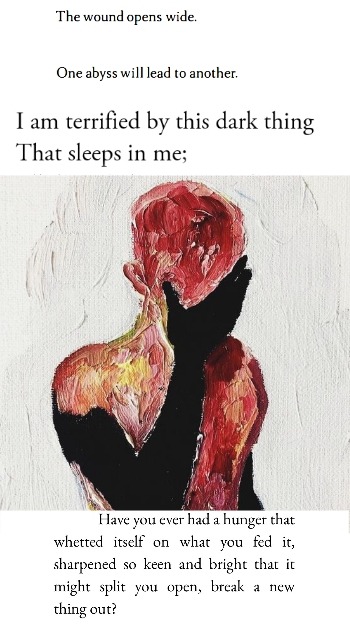


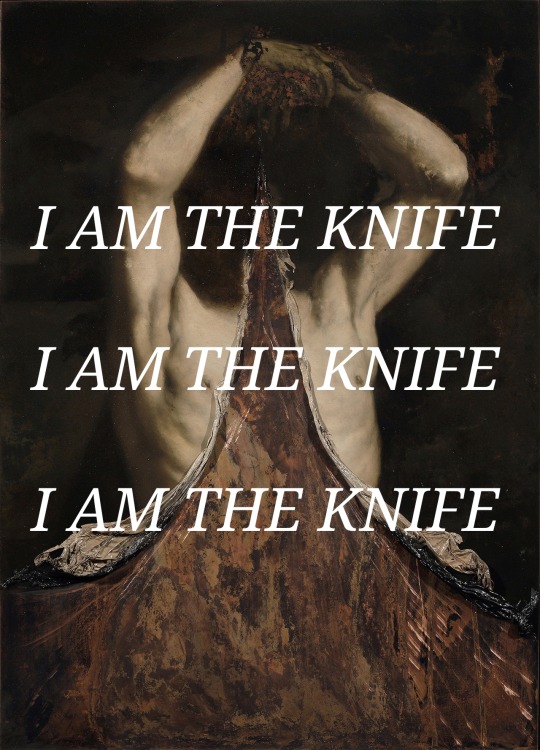

web weaving for my oc, Warden
Nathaniel Orion G.K. / Crush, Richard Siken / Dazzled Precise, Anna de Noailles tr. Norman R. Shapiro / Wishbone, Richard Siken / Overflowing With Empty, Judas H. / Waterborne, Natasha Trethewey / The Night There, Mahmoud Darwish / Elm, Sylvia Plath / Amal El-Mothar / The Third Hour of The Night, Frank Bidart / Hamlet, Shakespeare / The Unabridged Journals of Sylvia Plath, Sylvia Plath / Daddy, Ramesy / Another Road in The Road, Mahmoud Darwish / @pikslasrce / Ariel, Aneleh / Tragedy, Sanna Wani / Nicola Samori / Underbelly, Nicole Homer / Beric Dondarrion
1K notes
·
View notes
Text
A list of all the books mentioned in Peter Doherty's journals (and in some interviews/lyrics, too)
Because I just made this list in answer to someone's question on a facebook group, I thought I may as well post it here.
-The Picture of Dorian Gray/The Ballad Of Reading Gaol/Salome/The Happy Prince/The Duchess of Padua, all by Oscar Wilde -The Thief's Journal/Our Lady Of The Flowers/Miracle Of The Rose, all by Jean Genet -A Diamond Guitar by Truman Capote -Mixed Essays by Matthew Arnold -Venus In Furs by Leopold Sacher-Masoch -The Ministry Of Fear by Graham Greene -Brighton Rock by Graham Green -A Season in Hell by Arthur Rimbaud -The Street Of Crocodiles (aka Cinnamon Shops) by Bruno Schulz -Opium: The Diary Of His Cure by Jean Cocteau -The Lost Weekend by Charles Jackson -Howl by Allen Ginsberg -Women In Love by DH Lawrence -The Tempest by William Shakespeare -Trilby by George du Maurier -The Vision Of Jean Genet by Richard Coe -"Literature And The Crisis" by Isaiah Berlin -Le Cid by Pierre Corneille -The Paris Peasant by Louis Aragon -Junky by William S Burroughs -Absolute Beginners by Colin MacInnes -Futz by Rochelle Owens -They Shoot Horses Don't They? by Horace McCoy -"An Inquiry On Love" by La revolution surrealiste magazine -Idea by Michael Drayton -"The Nymph's Reply to The Shepherd" by Sir Walter Raleigh -Hamlet by William Shakespeare -The Silver Shilling/The Old Church Bell/The Snail And The Rose Tree all by Hans Christian Andersen -120 Days Of Sodom by Marquis de Sade -Letters To A Young Poet by Rainer Maria Rilke -Poetics Of Space by Gaston Bachelard -In Favor Of The Sensitive Man and Other Essays by Anais Nin -La Batarde by Violette LeDuc -Lolita by Vladimir Nabokov -Intimate Journals by Charles Baudelaire -Juno And The Paycock by Sean O'Casey -England Is Mine by Michael Bracewell -"The Prelude" by William Wordsworth -Noise: The Political Economy of Music by Jacques Atalli -"Elm" by Sylvia Plath -"I am pleased with my sight..." by Rumi -She Stoops To Conquer by Oliver Goldsmith -Amphitryon by John Dryden -Oscar Wilde by Richard Ellman -The Song Of The South by James Rennell Rodd -In Her Praise by Robert Graves -"For That He Looked Not Upon Her" by George Gascoigne -"Order And Disorder" by Lucy Hutchinson -Man Crazy by Joyce Carol Oates -A Pictorial History Of Sex In The Movies by Jeremy Pascall and Clyde Jeavons -Anarchy State & Utopia by Robert Nozick -"Limbo" by Samuel Taylor Coleridge -Men In Love: Masculinity and Sexuality in the Eighteenth Century by George Haggerty
[arbitrary line break because tumble hates lists apparently]
-Crime And Punishment by Fyodor Dostoevsky -Innocent When You Dream: the Tom Waits Reader -"Identity Card" by Mahmoud Darwish -Ulysses by James Joyce -The Four Quartets poems by TS Eliot -Julius Caesar by William Shakespeare -A'Rebours/Against The Grain by Joris-Karl Huysmans -Prisoner Of Love by Jean Genet -Down And Out In Paris And London by George Orwell -The Man With The Golden Arm by Nelson Algren -Revolutionary Road by Richard Yates -"Epitaph To A Dog" by Lord Byron -Cocaine Nights by JG Ballard -"Not By Bread Alone" by James Terry White -Anecdotes Of The Late Samuel Johnson by Hester Thrale -"The Owl And The Pussycat" by Edward Lear -"Chevaux de bois" by Paul Verlaine -A Strong Song Tows Us: The Life of Basil Bunting by Richard Burton -Don Quixote by Miguel de Cervantes -The Divine Comedy by Dante Alighieri -The Jungle Book by Rudyard Kipling -The Man Who Would Be King by Rudyard Kipling -Ask The Dust by John Frante -On The Trans-Siberian Railways by Blaise Cendrars -The 39 Steps by John Buchan -The Overcoat by Nikolai Gogol -The Government Inspector by Nikolai Gogol -The Iliad by Homer -Heart Of Darkness by Joseph Conrad -The Volunteer by Shane O'Doherty -Twenty Love Poems and A Song Of Despair by Pablo Neruda -"May Banners" by Arthur Rimbaud -Literary Outlaw: The life and times of William S Burroughs by Ted Morgan -The Penguin Dorothy Parker -Smoke by William Faulkner -Hero And Leander by Christopher Marlowe -My Lady Nicotine by JM Barrie -All I Ever Wrote by Ronnie Barker -The Libertine by Stephen Jeffreys -On Murder Considered As One Of The Fine Arts by Thomas de Quincey -The Void Ratio by Shane Levene and Karolina Urbaniak -The Remains Of The Day by Kazuo Ishiguro -Dead Fingers Talk by William S Burroughs -The England's Dreaming Tapes by Jon Savage -London Underworld by Henry Mayhew
112 notes
·
View notes
Text
get to know me <33
• my name is Jeanté
• i'm libra & infp
• music taste: lana del rey, taylor swift, the cure, london after midnight, lareine, abba, nirvana, bauhaus, buck-tick, the smiths, him, evanescence, glamscure, the beatles, elvis presley, my chemical romance, siouxsie and the banshees, hole, sisters of mercy, david bowie, laufey, cigarettes after sex, vampire rose, the doors, malize mizer & type o negative
• fav films: edward scissorhands, girl interrupted, the aristocats, sabrina (1954), interview with the vampire, romeo & juliet (1968), thirteen, corpse bride, the crow (1994), 10 things i hate about you, jennifer's body, halloween, a nightmare before christmas, mirror mirror (1990), the craft, heathers, ginger snaps, sherlock jr, speak, white oleander, the addams family values, a nightmare on elm street, beetlejuice, the love witch, candy (1968), repulsion, black swan, the swan princess, the last unicorn, the princess & the frog, perfect blue, casablanca, gone with the wind, helter skelter (2019) & valerie and her week of wonders
• fav series: friends, gilmore girls, american horror story, sailor moon, chobits, death note, the office, queen's gambit, gossip girl, the golden girls, full house, kakegurui, neon genesis evangelion, castlevania, the vampire diaries, the rose of versailles, nana, the munsters & ergo proxy
• fav books: pride & prejudice, emma, the secret history, dracula, frankenstein, crime and punishment, hamlet, my year of rest and relaxation, little women, wuthering heights, the picture of dorian gray, jane eyre, the stranger, the metamorphosis, the great gatsby, anna karenina, war and peace, the bell jar & white nights
• things i love: 60s/70s fashion, vintage items, ballet, russian literature, poetry, v-kei, anime, shakespeare, tim burton films, old barbie, coffee, history, cats & 80s horror movies
❤︎ pinterest
#this is what makes us girls#girlblogging#this is a girlblog#hell is a teenage girl#i'm just a girl#lana del rey#lizzy grant aesthetic#coquette#Spotify
54 notes
·
View notes
Text

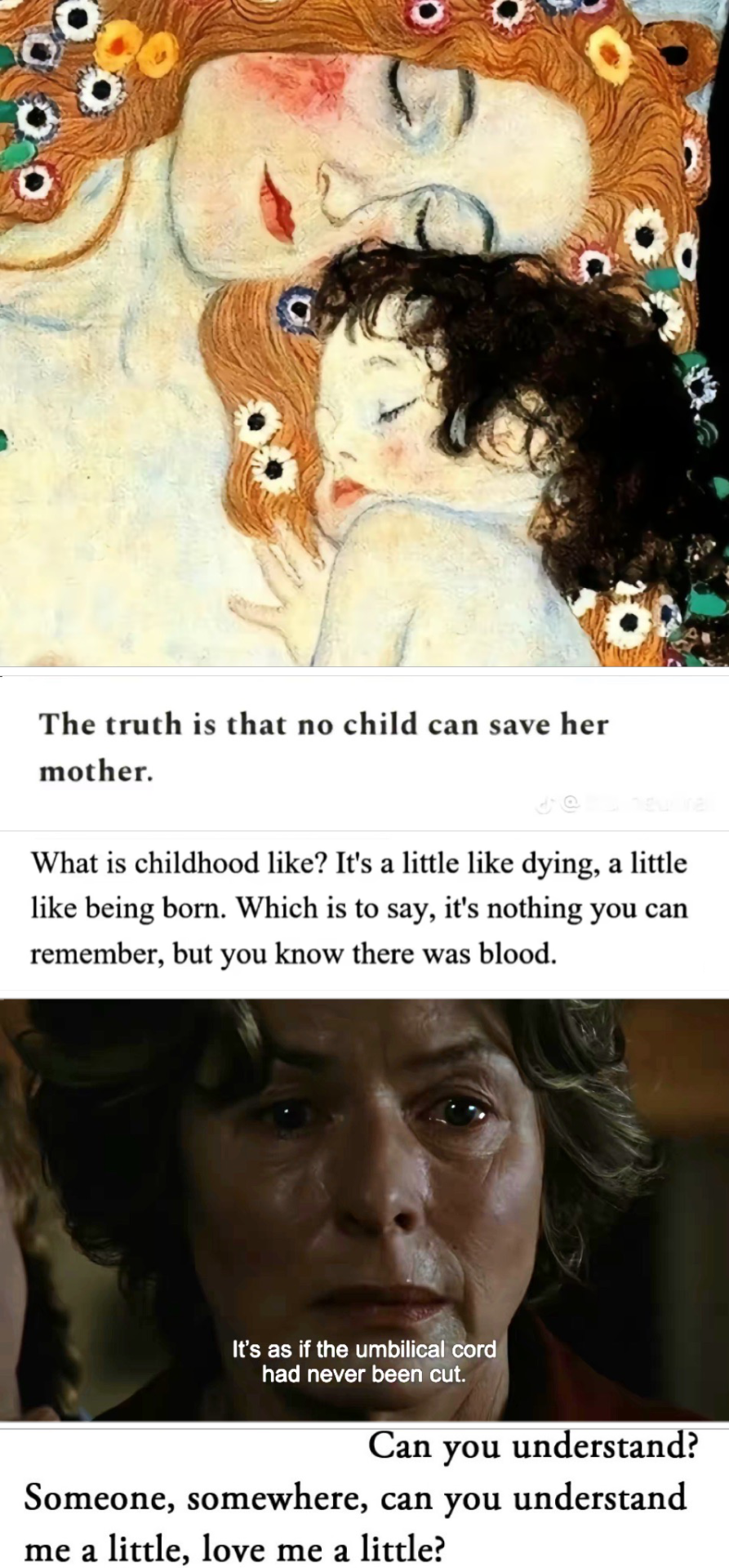


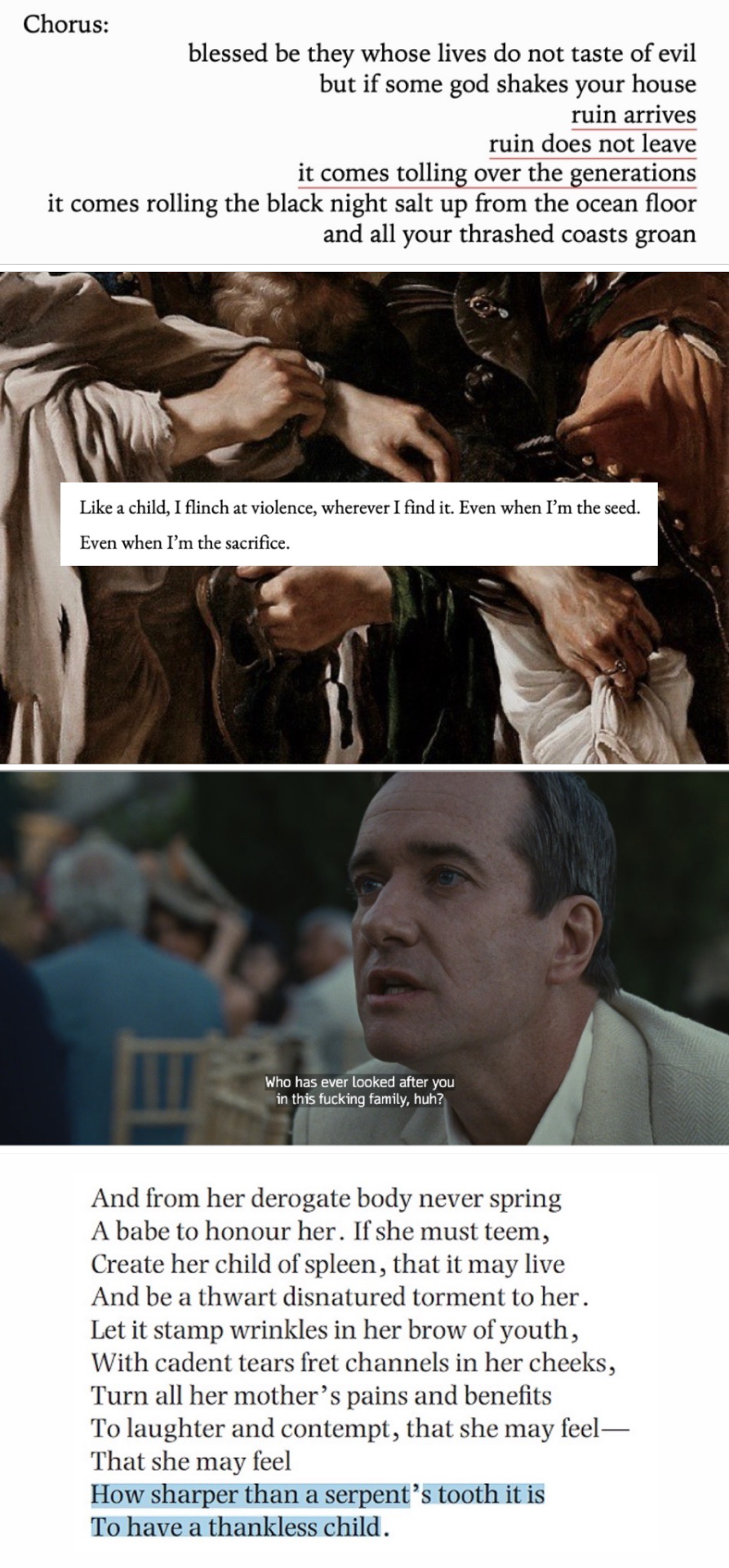
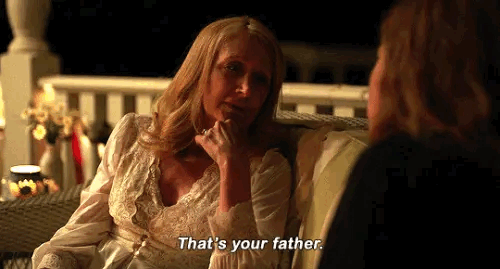
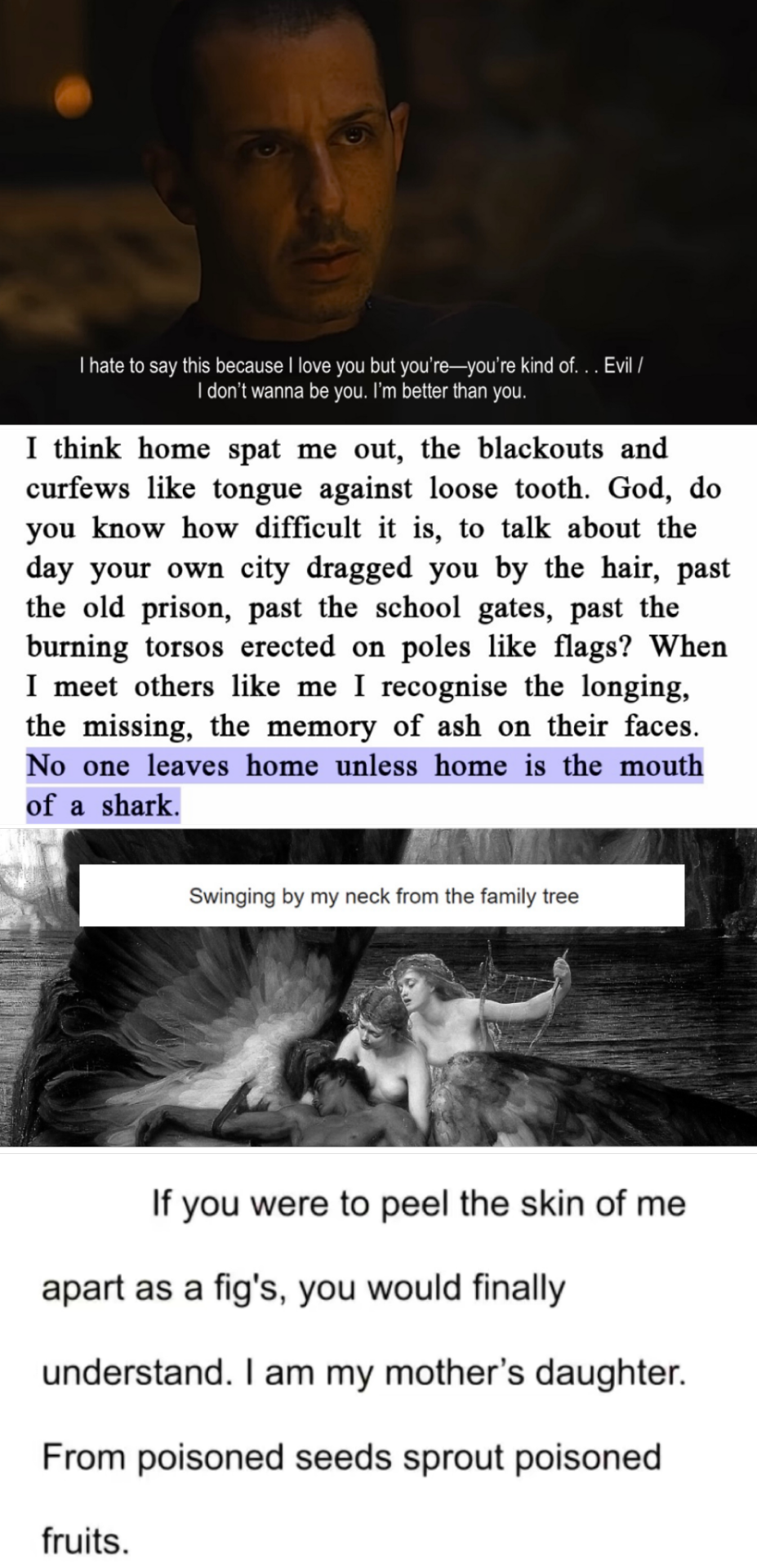
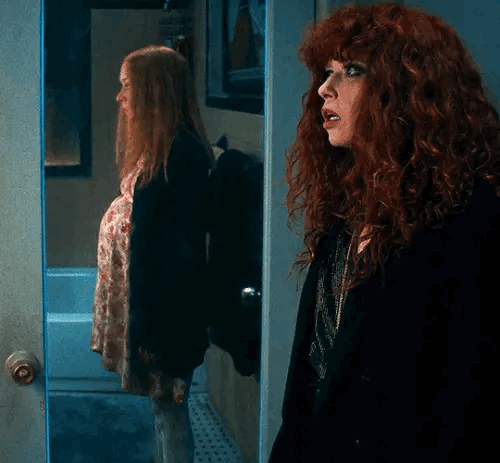
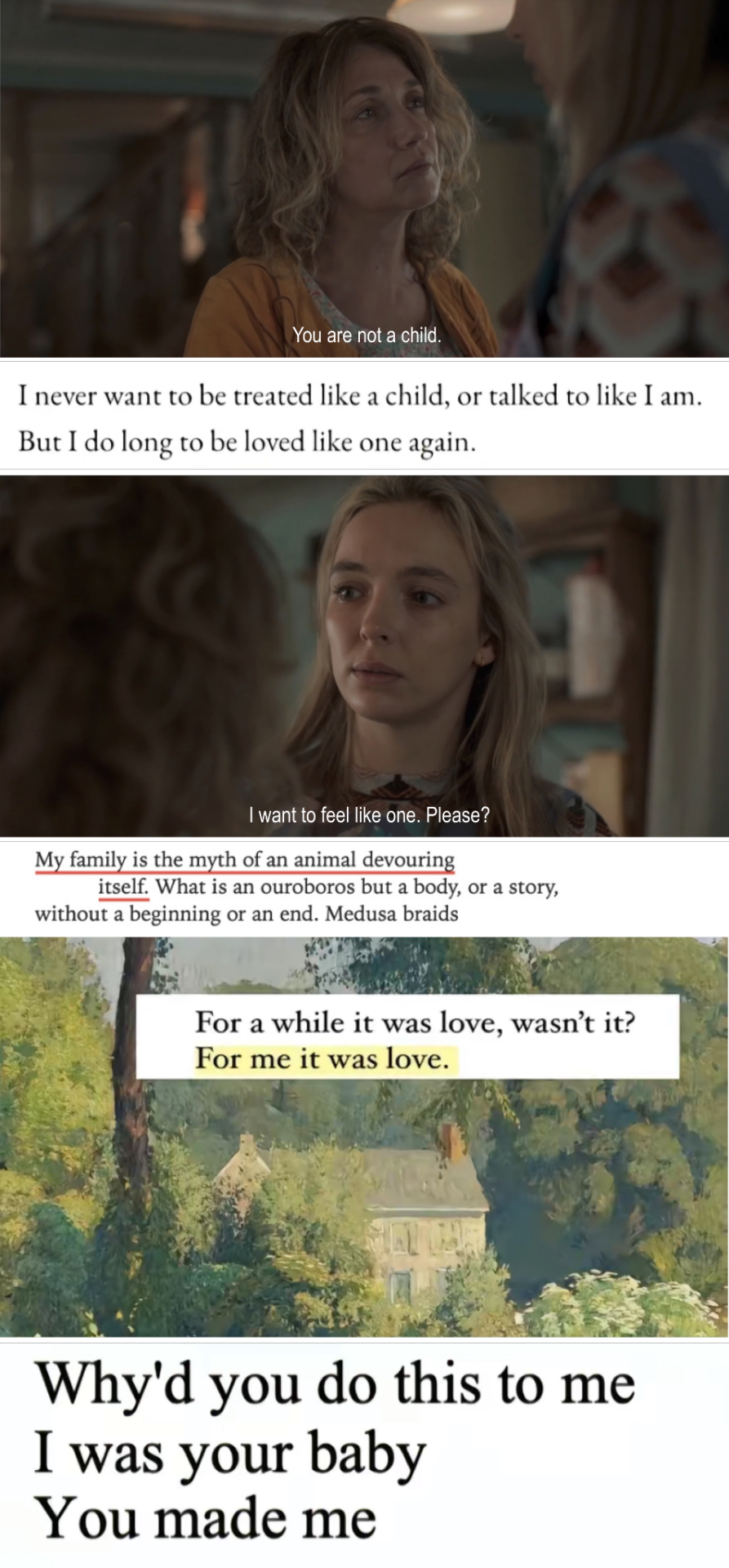

MAYBE THE POISON DRIPS THROUGH.
Kendall Roy (Succession. CR: @humanveil) / Mother and Child — Gustav Klimt / Autumn Sonata — Ingmar Bergman / The Journals of Sylvia Plath — Sylvia Plath / Fleabag — Phoebe Waller-Bridge (CR: limitedseries) / 1804/ Autobiography — Dan Pagis / Villanelle (Killing Eve) / Lindsay C. Gibson / Olivia Benson (Law & Order: SVU) / Sharp Objects — Gillian Flynn & Jean-Marc Vallée / Teaching My Mother How To Give Birth — Warsan Shire / Family Tree — Ethel Cain / The Lament for Icarus — Herbert Draper / Russian Doll — (CR: CTO, I found it on pinterest) / Stavros Kazantzidis / Susan Smith — Wych Elm / Antigonick — Anne Carson / Slaughterhouse — Yves Olade / The Return of the Prodigal Son — Guercino, 1619 / King Lear — Shakespeare
#periphery#web weaving#mommy issues#daddy issues#family#generational trauma#mother#russian doll#sharp objects#compilation#mommy issues web weaving#toxic family#poetry#on family#art#succession#kendall roy#killing eve#writing#poem#phoebe bridgers#dark academia#love#heartbreak#web weave#on heartbreak#on toxic families#words#text#quote
274 notes
·
View notes
Text










“For Aemond’s walk, there was something I found interesting about Eighties horror icons,” Mitchell says in a murmur, barely audible above the incongruous disco muzak of the tea room we’ve moved to, his face half hidden beneath a black baseball cap. The only dash of colour on his person is a Help for Heroes wristband. “No matter how slow they walk, they always catch up with Jamie Lee Curtis,” he says, a smile twitching at the corners of his more-Joker-than-The-Joker lips. “There’s something in the physicality of [Elm Street’s] Freddy [Krueger], [Jamie Lee’s Halloween nemesis] Michael Myers, [the Creeper in] Jeepers Creepers.” Aemond, he says, also wears “a big, long duster coat”. Very boogeyman-adjacent. “And Shakespeare,” he continues, “he said that the eyes are the windows to the soul. So what does that mean to only have one of them? How do you compensate? Is it through physicality? Aemond’s such a boiling pot of emotions anyway, that just because he’s smiling doesn’t mean he’s happy. He’s ready to go at any minute.” What about the Adidas trackie bottoms and hoodie Mitchell’s wearing today – does he always dress in black? “I do nowadays, yeah. There’s just something about the power of representing [him]. There’s a Johnny Cash music video, [for] God’s Gonna Cut You Down, and someone says in that that wearing black stands for the poor and the downtrodden. And that’s what Aemond is.”
Ewan Mitchell for THE FACE Magazine
photographed by Jules Moskovtchenko (March 2023)
#ewan mitchell#aemond targaryen#house of the dragon#hotd#hotdedit#aemondtargaryenedit#aemondtargaryensource#*actors#ours
347 notes
·
View notes
Text
Laika and Frankenweenie Headcanons (The Laika Show
• Coraline's birthday is December 27
• Norman's birthday is February 12
• Eggs' birthday is May 9
• Kubo's birthday is February 22
• Prue's birthday is November 13
• Curtis' birthday is February 14
• Wybie's birthday is October 28
• Neil's birthday is June 28
• Winnie's birthday is June 9
• Aggie's birthday is October 9
• Victor's birthday is August 31
• Elsa's birthday is October 29
• Vincent's birthday is December 5
• Kat's birthday is April 17
• Raúl's birthday is January 20
• Raz's birthday is March 26
• Lili's birthday is July 4
• Sir Lionel now has a hatred towards Woody and the Toy Story films in general after losing an Oscar to 4.
• Adelina thinks Ember is a CIA agent who is spying on them and secretly evil.
• Norman's parents were married in 1993.
• The Laika Crew drives a gray SUV resembling that of a 1973-1991 Chevrolet Suburban and based on a Rancher XL from GTA 5.
• Kubo's house address is 234 Elm Street (the same as Andy's House revealed in Toy Story 3)
• Coraline's parents were married in 1996.
• The kids attend Abernethy Middle School.
• Victor's parents were married on April 4.
• For the first 88 episodes of the series, the crew (not counting Kubo's friends) live in an apartment, after the first movie, they move into the house they have for the remainder of the series.
• Coraline's full name is Coraline Anna Penelope Jones
• Norman's full name is Norman Jonathan Babcock
• Eggs' full birth name is Arthur Herbert Trubshaw
• Kubo's full name is Kubo Mahoro
• Prue's full name is Prue Marie McKeel
• Wybie's full name is Wyborn Downey Lovat
• Neil's full name is Neil Emile Downe
• Winnie's full name is Winifred Mary Portley-Rind
• Aggie's full name is Agatha Michelle Prenderghast
• Victor's full name is Victor Charles Frankenstein
• Elsa's full name is Elsa Anais Van Helsing
• Vincent's full name is Vincent Sebastian Malloy
• Kat's full name is Katherine Koniqua Elliot
• Raúl's full name is Raúl Liam Cocolotl
• Raz's full name is Razputin Jason Aquato
• Lili's full name is Lili Maya Zanotto
• Eggs has speluncaphobia (fear of caves)
• Elsa has nyctohylophobia (fear of forests at night)
• Kubo has an allergy against dust mites
• Victor and Elsa have crushes on each other, but are too shy to say anything
• Elsa isn't into sports, but enjoys swimming and roller skating on occasion
• Coraline would dye her hair pink as a secondary color
• Aggie is a Futurama fan and has posters and collectibles in her room
• Lionel would rather listen to Miley Cyrus after 2013 than the Woody's Roundup theme song
• Adelina's parents are millionaires living in New Jersey
• Each main character has a color to signify them, they are blue (Coraline), green (Norman), yellow (Eggs), and red (Kubo).
• Victor likes to watch both horror and sci-fi films. His favorites are Karloff’s “Frankenstein”, “The Fly”, “The Beast from 20,000 Fathoms”, “Behemoth the Sea Monster”, and “Earth vs. the Flying Saucers”
• Eggs keeps SpongeBob stickers on his dresser
• Victor and Elsa first met on their first day in kindergarten. They both reached out to grab the same toy, but their hands touched and their eyes met. After a tiny squabble over the toy, they started playing together and they quickly became friends
• Elsa is highly allergic to bees and pistachios
• Coraline has a secret stash where she keeps her Simpsons DVDs
• Eggs' house address is 1225 Sycamore Street (Bonnie's in TS3), and is only around the corner from Kubo's (post-movie episodes only)
• Elsa’s favorite books are “To Kill a Mockingbird”, “Alice’s Adventures in Wonderland”, “The Legend of Sleepy Hollow”, “Romeo and Juliet” and other works of William Shakespeare and her favorite writers are Lewis Carroll, Harper Lee, and Shakespeare. She also enjoys Edgar Allen Poe’s works
• Kubo keeps up Japanese culture posters in his room, as well as his shamisen, collectibles on his shelves and dresser. A gaming PC setup on his desk. And a darts on his bedroom door
#laika studios#coraline#paranorman#the boxtrolls#kubo and the two strings#missing link#frankenweenie#wendell and wild#psychonauts#headcanon#the laika show
4 notes
·
View notes
Text
"In a literal sense, the Vikings are of course people of the past, dead and gone—but at the same time they inhabit a curiously haptic kind of prehistory, one that appears to return whatever pressure is applied to it. Many have been tempted to put their fingers on the scales of hindsight and imagined that the impulse to do so came not from themselves but through the revelation of hidden truths buried by time. Medieval monks and scholars reinvented their pagan ancestors either as nobly misguided forebears or as agents of the devil. In the manuscript illuminations of Romance literature, with a kind of Orientalist prejudice, they became Saracens, enemies of Christ depicted with turbans and scimitars. In Shakespeare’s England, the Vikings were taken up as violent catalysts in the early story of the kingdom’s greatness. Rediscovered during the Enlightenment as a sort of ‘noble savage’, the figure of the Viking was enthusiastically adopted by the nationalist Romantics of the eighteenth and nineteenth centuries. Searching for their own emerging identities, Victorian imperialists scoured Scandinavian literature looking for suitably assertive northern role models, expressing the manifest destiny of the Anglo-Saxons through their Nordic cousins. The logical end of that trajectory came a century later, when the Nazis appropriated the Vikings in pursuit of their racist fictions, elevating them as a spurious Aryan archetype; their modern successors still plague us today. Elements of the broad Pagan community now seek a spiritual alternative that draws inspiration from Viking religion, with Tolkienesque flavourings added to a cloudier Old Norse brew. All these and many more, including today’s academics and the audiences for historical drama, have taken the fragmentary material and textual remains of the Vikings and recast them in moulds of their choosing. At times it can seem that the actual people have almost disappeared under the cumulative freight they have been made to bear."
- Neil Price, “Children of Ash and Elm: A History of the Vikings”
#history#norse history#vikings#viking age#viking history#neil price#children of ash and elm#this was a phenomenally detailed and comprehensive book#queue#mine
44 notes
·
View notes
Note
The reasons for the outsized influence on the academic humanities of the French poststructuralists (as opposed to the more moderate critics of scientism such as Midgley) is no doubt overdetermined, but which explanations do you find most convincing?
I can only speak for the English department, but the most convincing answer is the most benign one, the one that least involves "Cultural Marxist" subversion of the west or CIA anti-communist skullduggery, the one immanent to the institution of academic criticism itself: the humanists had no theory of their practice, no global meta-discourse to guide individual instances of their discourse. This left them at a disadvantage in explaining themselves to their students and to the public in the face of scientific hegemony. They needed a system.
Academic criticism felt too amateurish, too gentlemanly, even after certain modernist assumptions had been assimilated by the middle of the century. New Criticism had rigor but you ran against its limitations very quickly, not even so much because of its ahistorical and Christian presuppositions, but because it only really works at all on certain types of texts, i.e., lyric poems of a riddling disposition, as well as the few larger forms that can look like such poems if you squint (early modern drama, for example, or modernist fiction). Psychoanalysis and Marxism in their pre-theory forms were too reductive, not even textual hermeneutics really, and therefore left the critic too little to say (Hamlet wants to sleep with his mother, Dickens is petit bourgeois: so what?); this goes, too, for the pre-theoretical attempts at identity politics, like early feminist criticism of the "images of women in literature" type. Myth criticism had a certain visionary appeal, but too often decayed into a predictable game of spot-the-archetype (another Christ figure in a modern novel? tell me a new one).[*]
On the other hand, the structuralist and poststructuralist ideas coming out of France promised a theory of language that was also a theory of society—even a theory that language was society and vice versa—and a therefore promised a systematic science of the literary text qua text as well as an Archimedean lever with which to shift the political (and indeed the scientific) in language. "Il n’y a pas de hors-texte." It opened up the whole world of European philosophy to Anglophone literary criticism and glamorously updated everything they were already doing with a self-conscious methodological sophistication. Close reading for balanced ambiguities became textual analysis aimed at subversive aporias.
This turn to englobalizing method would in the long run dissolve any plausible mission for literary studies per se as opposed to an "everything studies" that doubles as a "nothing studies," even as it ironically became the new cultural lingua franca of the whole educated class, supplanting the literary itself. I went to see the horror film It Lives Inside the other day. In the genre-obligatory high-school classroom scene, our heroine, her loyalties painfully divided between white American assimilation and her immigrant family's Hindu culture, tells her teacher that John Winthrop's city-on-a-hill sermon is, and I quote, "a normative fantasy." (The film then labors, with mixed success, to supply a rival normative fantasy.) 40 years ago, in A Nightmare on Elm Street, the teens in their English class just recited a scary speech from Shakespeare.
_______________________
[*] When I used to teach this class, I would look at various handbooks for undergraduates, and it was always interesting to see how they'd characterize the pre-theory era. Terry Eagleton in Literary Theory and Peter Barry in Beginning Theory tendentiously called it "liberal humanist," with their skeptical eye on the Arnoldian idea that literature could unify and redeem an otherwise class-ridden society; but Nicholas Birns in Theory After Theory more persuasively said it was the era of the "resolved symbolic," when critics had faith they could provide a final interpretive answer to the riddle of the isolated text, as opposed to theory's later claims that everything is a text and that texts by their nature are permanently open-ended.
2 notes
·
View notes
Text
Rebecca Goodheart, producing artistic director at Elm Shakespeare, and Sarah Bowles, director of education, began the festival by welcoming everyone to ECA’s theater at 55 Audubon St. “This is the first annual Elm Shakespeare youth festival,” she announced to loud applause. “You will have bragging rights for the next 30 years,” she said. “We hope this will grow and grow, because we believe that every young person in New Haven deserves to have a personal and impactful relationship with these words and these plays. We believe this is how we change the world. We’re so glad that you are with us for the start of this journey.”
Before coming to Elm Shakespeare, both Bowles and Goodheart had worked at Shakespeare & Company in Lenox, Mass., which has been doing a youth festival for decades. “That is, in many ways, how we became the artists that we are and the educators that we are,” Goodheart said. “They helped us know how to do this.”
8 notes
·
View notes
Text

.
After you come a few time to London (it’s my third time this year -visit 1 & visit 2) and you’ve seen the major tourist spots you start to just walk around. Since I love wandering around Paris and finding fun facts about the city I started to look for some interesting pieces about London
So this time I planned my walks to go check out
*The tallest door in London - Opened in 1904, it was once home to the Elms Lesters Painting Rooms, used to store and produce theatre scenery and backdrops. The tall door allowed the huge scenery to be maneuvered.

*The fence made of stretchers from WWII - During the war, many of London’s housing estates lost their original metal railings when they were manufactured into weaponry to serve the war effort. With a large stockpile of stretchers following the war, the London City Council decided to have the stretchers welded vertically together, fixed onto poles, sunken into concrete, and used to replace this missing fencing. The two kinks in the poles, designed so that they could be rested on the ground then picked up easily, can still be seen on the railings today.

*The House of St Barnabas / Charity House with the Victorian Penny chute for donation.

*St Bartholomew's Gatehouse - The earliest surviving timber framed facade in the City . It comprises a two-storey 16th century Tudor building with parts of the stonework and archway from the 13th century. It was the gatehouse to the Norman Priory church of St Bartholomew- the Great , founded in 1123.

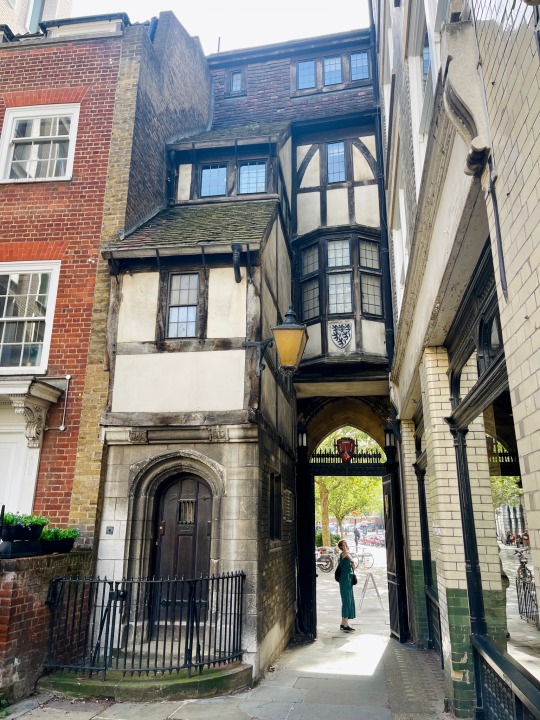
The first photo is the oldest churches in the city: St Bartholomew-the-Great (protect by the gate above) founded in 1123 as a Augustinian priory. It was fully restored in 1932 and it retains some of the 13th century stonework from the original nave. Fun facts: The church is featured in several films: Four wedding and a funeral; Shakespeare in Love, Avenger: Age of Ultron; Sherlock Holmes; Transformer: the last Knight; the Other Boleyn Girl.
2 notes
·
View notes
Text
Here's Some Extras:
Do you truly believe your mettle is any match for my cleverness?
These long hundred years have hardened me to your base tactics, do not presume you can sway me off the path as you so try to do.
The demons lurking in that infinite dark fear me more than you could ever comprehend, babe
May your lips always taste spoiled milk, and your bread forever be tainted by mold
I alas wish I can see you in that infinite light, but we both know that is not the path I shall travel.
Yes, the Walmart is on Elm Street
Should you ever eat corn I hope you choke on the kernel and require a fucking AMBULANCE (USA usage only)
No more, your strength is far too much for me, I yield eternally so! (Villain Use Only)
What, you egg? (Provided by Shakespeare)
No more do I deign it upon myself to describe my pains to you, for they are mine alone to hold.
Leave me to the musings of my past.
This journey is long, but it has not beaten me yet
Want to work on your conversational skills?
Use any of the following lines when you’re not sure what to say:
We must weather such things as we have always done
Look to my coming on the first light of the fifth day
Fall into the nothingness that awaits you and your master
Even the very wise do not see all ends
I wish none of this had happened
Go now, and die in what way seems best to you
3K notes
·
View notes
Text

#HARPERSMOVIECOLLECTION
2024 MOVIE LIST
www.tumblr.com/theharpermovieblog
I watched Cannibal Apocalypse (1980)
This was going to be a part of the Halloween marathon this year, but it was produced a year too late.
A couple of war vets are infected with a contagious cannibal disease.
Antonio Margheriti is a director of b-grade Italian horror and action films. You may recognize his name from being referenced in Quentin Tarantino films.
With this film, Margheriti dives into the world of war-trauma as horror. A theme covered in other films like "Dead Of Night" "Combat Shock" "House" and "Jacob's Ladder".
I like the lead actor of this film, John Saxon. He's appeared in several films I enjoy, "Enter The Dragon" a couple of "A Nightmare On Elm Street" films, and "Black Christmas", just to name a few. He's a good actor, with a filmography that speaks to a Drive-in nerd like myself. Apparently, while making this film, Saxon didn't get a well translated script, resulting in his belief that he was making a psychological thriller and not a gory splatter film....well, he was kind of right.
Vetsploitation is a sub-genre of horror, action and some drama, which mainly depicts the difficulties of Vietnam era veterans. Basically it uses those veteran's experiences as a jumping off point. And, honestly, it's not a bad way to start a story, especially a horror story. PTSD is scary enough to deal with, but a B-Horror film like Cannibal Apocalypse provides a more blunt metaphor for what PTSD can do to individuals and the community at large.
Now, all that being said, this is an Antonio Margheriti movie called "Cannibal Apocalypse" and we aren't exactly attempting Shakespeare, Oscar caliber or anything more than an exploitation film.
Yes, this movie is dumb and a little silly. The first hour is pretty boring, but tolerable. By the third act we are basically rooting for a foursome of Cannibals, and I have to admit, I was intrigued to see what was going to happen. It's a strange idea that our cannibals are just regular people infected with the need to eat other people. I wish it was an idea that could have been expanded upon more, and used more efficiently.
So, yeah I didn't hate it overall, but I didn't come close to liking it either. It was fine enough for a nerd like myself.
There's a bit of cheesy/fun gore, some unintentional laughs and funky jazz music, but sadly, the last half hour of this movie is the whole movie.
0 notes
Text
(Anne) Hathaway
whole range of botanical studies
Mr. Baker of Kew
West Parts of England
sacred Crown of Thorns
picture of desolation
woe of Milton's
parings of one's
it of its
receipt of Fern
instrument of gambling
Bullein's Book of Simples
month of June
other parts of Europe
Garlick of Egypt
writers of Shakespeare's
wood Hyacinths of Scotland
writings of St
Merchant of Venice
Dromio of Syracuse
Hyacinths her fields of Poppies
its name of Fumitoryfumeterre
good clove of Garlic.The
South of Europe
beauties of country
weight of sugar
others of its
wild scenery of England
Flax of commerce
kinde of Ferne
109:1] 'Dust of sapphire
expert apothecarie William Dries of Antwerp
brooks of defence
smaller masses of colour
doctrine of signatures
Boke of Nurture
kinds of Ginger
crop of Flax
Plain of Marathon
corruption of Crossberry
type of intense greenness
Humfrey Duke of Gloucester
tune of Green
mother of Moses
luce of France
brilliant masses of colour
common Elm of our
robe of white Fills
opinion of his
0 notes
Text
New Blog: A Quandary, A Conundrum, A Dilemma
I have a quandary, a conundrum, a dilemma. I have a new book by one of my favorite authors and I am struggling to read it. Not because of the characters; they are very interesting. Not because of the story lines; I just read a similar book by another author. It is because it is about Shakespeare and somehow I just missed the gene that finds him interesting and his writing superb. So what do I do?
Meanwhile I read another book online about Werewolves, wolves and people. Again the wolves were broken down into packs with an Alpha and a Beta with their mates being called a Luna. This time they added another category of wolves, called the omegas. The lowest of all the classes where they are expected to be housekeepers and cooks, and seamstresses to the pack. The book was called The Omegas Best Friend by Sasha Johnson. I ended up reading it online at a site where it was free, however, quite often there were pages that were all messed up and perhaps in a different language. I was never sure.
I also read Kristan Higgins’ newest book Look On the Bright Side. What a great novel that was. I enjoyed the main character of Lark and her family. I enjoyed the story line, although I did need tissues, a bunch of tissues. The story line does go back and forth in time (staying with Lark). There are also chapters with other characters being the narrator to tell various parts of the story. The book was fascinating in that respect. I really enjoyed it.
Elise sent us in an interview with Alyssa Maxwell about two of her novels (Murder at the Elms and Murder at Vinland). The novels take place during the gilded age in Newport RI. Along with the historical aspect of the rich and famous people, there is a mystery to be solved in each book by Emma Cross. Both of the books sound like fun reads. Elise also sent us a review of the newest Tom Clancy Shadow State books written by M P Woodward featuring Jack Ryan.
Meanwhile I am going to read another book…not about Shakespear.
0 notes